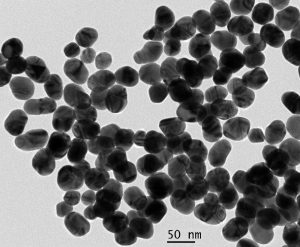Medical devices often induce bad reactions from the patient’s immune system. Although nanoscale structures on the surface are known to affect how the body responds we don’t know much about how they do it. This makes it difficult to design devices with predictable interactions with cells.
Researchers at the University of South Australia recently published the first evidence that the size of surface features affects the shape of a large protein called fibrinogen. This protein causes inflammatory responses, blood clotting and other blood processes. The research team attached 16, 38, and 68 nanometre diameter gold nanoparticles to surfaces at different densities to see what effect this had on fibrinogen and the immune system.
By using a multitude of microscopy and microanalysis techniques at the Microscopy Australia, combined with an array of other analytical techniques, they found that surfaces with 16 and 68 nanometre features increased inflammation whereas 38 nanometre features, reduced inflammation. This is likely to be because fibrinogen is 45 nanometres long and would be less strained when it interacts with the 38 nm particles. The smaller and larger particles cause fibrinogen to bend more and expose internal parts of the molecule that are not normally seen be the immune system.
These results should lead to
• Safer biomedical devices
• Improved patient satisfaction and quality of life
• Reduced health burden associated with implants
• Reduced economic burden due to adverse reactions from implanted devices.
Visalakshan, R. M., Cavallaro, A. A., MacGregor, M. N., Lawrence, E. P., Koynov, K., Hayball, J. D., & Vasilev, K. (2019). Nanotopography‐Induced Unfolding of Fibrinogen Modulates Leukocyte Binding and Activation. Advanced Functional Materials, 29(14), 1807453. https://doi.org/10.1002/adfm.201807453
November 28, 2019